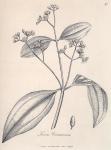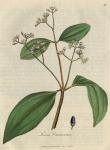027. Laurus cinnamomum. Cinnamon-tree.

 Synonyma. Cinnamomum. Pharm. Lond. & Edin.
Synonyma. Cinnamomum. Pharm. Lond. & Edin.
Cassia cinnamomea. Herm. Lugd. Bat. 129. t. 655. Pluk. Almag. 88.
Cinnamomum foliis latis ovatis frugiferum. Burm. Zeyl. 62. t. 27.
Arbor canellifera Zeylanica, cortice acerrimo seu praestantissimo, qui Cinnamomum Officinarum. Breyn. Prod. ii. 17.
Cinnamomum sive Canella Zeylanica. Bauh. Pin. 408.
Canella seu Cinnamomum vulgare. Bauh. Hist. 1446.
The Cinnamon-tree of Ceylon. Raii Hist. 1561.
Laurus Cinnamomum. Jacq. Americ. p. 59. t. 117.
Rasse Coronde. Zeylonarum.
Class Enneandria. Ord. Monogynia. L. Gen. Plant. 509.
Ess. Gen. Ch. Cal. o. Cor. calycina, 6 partita. Nectarium glandulis 3, bisetis, germen cingentibus. Filamenta interiora glandulifera. Drupa 1-sperma.
Spec. Char. L. foliis trinerviis ovato-oblongis: nervis versus apicem evanescentibus.
This valuable and elegant laurel rises above twenty feet in height; the trunk extends about six feet in length, and one foot and a half in diameter; it sends off numerous branches, which are covered with smooth bark, of a brownish ash colour; the leaves stand in opposite pairs upon short footstalks; they are of an ovalish oblong shape, obtusely pointed, entire, firm, from three to five inches long, of a bright green colour, and marked with three whitish longitudinal nerves; the common peduncles grow from the younger branches, and after dividing, produce the flowers in a kind of paniculated umbel. The petals are six, oval, pointed, concave, spreading, of a greenish white or yellowish colour, and the three outermost are broader than the others; the filaments are nine, shorter than the corolla, flattish, erect, standing in ternaries, and, at the base of each of the three innermost, two small round glands are placed; the anthers are double, and unite over the top of the filament; the germen is oblong, the style simple, of the length of the stamina, and the stigma is depressed and triangular: the fruit is a pulpy pericarpium, resembling a small olive of a Jeep blue colour inserted in the corolla, and containing an oblong nut.
The true Cinnamon-tree is a native of Ceylon, where, according to Ray, it grows as common in the woods and hedges as the hazel with us, and is used by the Ceylonese for fuel and other domestic purposes. Its cultivation was first attempted in this country about the year 1768 by Mr. Philip Miller, who observes "that the Cinnamon and Camphire-trees are very near akin," and that if the berries of these trees were procured from the places of their growth, and planted in tubs of earth, the plants might be more easily reared than by layers, which require two years or more before they take root. We wish, however, to caution those who make the trial, to plant this fruit immediately upon being obtained from the tree; for Jacquin remarks, "Caeterum ad sationem transportari semina nequeunt, quum paucos intra dies nuclei corrumpantur, atque effoeti evadunt." [Jacquin's Americ. At Ceylon, "it is particularly owing to a certain kind of Wild Doves, which, from their seeding on the fruit of the Cinnamon-tree, they call Cinnamon-eaters, that these trees grow so plentifully in this island." A. Seba Ph. Trans. vol. 36. p. 105.] Ray seems to think that the Cassia cinnamomea of Herman, the Cassia lignea, and the Cassia fistula of the ancient Greek writers, were the same, or varieties of the same species of plant. [It is necessary to observe, that the ancient signification of these names is very different from the modern. The younger branches of the tree, with their bark covering them, were called by the Greek writers (greek) Cinnamomum, and sometimes (greek), or Cassia lignea; but when they were diverted of their bark, which by its being dried became tubular, this bark was denominated (greek), or cassia fistula.—But as in process of time the wood of this tree was found useless, they stripped the bark from it, and brought that only; which custom prevails at this day. See Account of the Cinnamon-tree by Dr. Watson, Phil. Trans. vol. 47.] But an inquiry of more importance is, whether the Cinnamon of Ceylon is of the same species as that growing in Malabar, Sumatra, &c. differing only through the influence of the soil and climate in which it grows, or from the culture or manner of curing the Cinnamon. Mr. White and Mr. Combes, who have investigated this subject with considerable attention, agree with Gracias, and determine this question in the affirmative.
[According to many botanical writers the principal marks of distinction of these plants are to be found in the leaf, which in the Cinnamon of Ceylon is more oval and less pointed than the others, and the nerves do not reach to the margin; while in the Cinnamon of Sumatra they are said to be continued to the extremity of the leaf.
—Respecting the bark it is well known to be less warm and grateful to the taste, manifesting that viscosity on being chewed which is never observable in the Ceylon Cinnamon. But Mr. White, with the assistance of Dr. Matty, carefully compared the specimens of the Cinnamon-tree, (commonly called Cassia) which he had from Sumatra, with those from Ceylon, preserved in the British Museum, which were the collections of Boerhaave, Courteen, Plukenet, and Petiver, and found the difference so inconsiderable, as fully to justify his opinion. In Murray's edition of the Systema Veg. we find superadded to the description of Cassia, "Esse modo Varietatem praecedentis, (Cinnam.) foliis angustioribus et obtusioribus, Thunberg in Act. Stockh. 1780. p. 56. The difference of the bark itself is thus stated by Ray, "Officinae nostrae Cassiam ligneam a Cinnamomo seu Canella distinctam faciunt, Cassiam Cinnamomo crassiorem plerumque esse colore rubicundiorem, substantia duriorem, solidiorem & compadtiorem, gustu magis glutinoso, odore quidem & sapore Cinnamomum aptius referre, tamen Cinnamomo imbecilliorem & minus vegetam esse ex accurata observatione. Tho. Johnfon." But Mr. White says, "From the specimens I shall now produce, it will most plainly appear, that these differences are merely accidents, arising from the age of the Canella, the part of the tree from whence it is gathered, and from the manner of cultivating and curing it." And he observes, "If any conjecture can arise from hence, it may be, that the Cinnamon of Ceylon was formerly, as well as that of Sumatra and Malabar, called Cassia; but that the Dutch writers, being acquainted with the excellent qualities which the ancients ascribed to their Cinnamon, chose to add the name Cinnamon to that of Cassia; and in process of time they have found the name of Cinnamon more profitable than that of Cassia, by which we chuse to call our Canella, to our national loss of many thousands a year." (Phil. Trans. vol. 50. p. 887.) How far the reasoning of Mr. White is really well founded, we leave to the judgment of others; it may however be remarked, that his opinion is not a little supported, from the consideration that the Cinnamon plant varies exceedingly, even in the island of Ceylon, where Burman collected nine different sorts, and Seba actually describes ten.]
The use of the Cinnamon-tree is not confined to the bark, for it is remarkable that the leaves, the fruit, and the root, all yield oils of very different qualities, and of considerable value: that produced from the leaves is called Oil of Cloves, and Oleum Malabathri: that obtained from the fruit is extremely fragrant, of a thick consistence, and at Ceylon is made into candles, for the sole use of the King; and the bark of the root not only affords an aromatic essential oil, or what has been called Oil of Camphor, and of great estimation for its medical use, but also a species of camphor, which is much purer and whiter than that kept in the shops.
The spice, so well known to us by the name of Cinnamon, is the inner bark of the tree; ["If you taste the inner membrane of the bark when fresh taken off, you will find it of most exquisite sweetness, whereas the outward part of the bark differs but very little in taste from the common trees; but in drying, the oily and agreeable sweetness communicates and diffuses itself throughout the whole outward part." Seba l. c.] and those plants produce it in the most perfect state, which are about six or seven years old, but this must vary according to circumstances. Seba says, "Those which grow in the vallies, where the ground is a fine whitish sand, (and there are many such vallies in the island of Ceylon) will in five years time be fit to have the bark taken off. Others, on the contrary, which stand in a wet slimy foil, must have seven or eight years time to grow before they are ripe enough." And the bark of those trees, which stand in a very dry soil, and much exposed to the sun, has often a bitterish taste, which Seba attributes to "the camphor being by the sun's rays rendered so thin and volatile, that it rises up and mixes with the juice of the tree." The bark, while on the trees, is first freed of its external greenish coat; it is then cut longitudinally, dripped from the trees, and dried in sand, till it becomes fit for the market, when it is of a reddish yellow, or pale rusty iron colour, very light, thin, and curling up into quills or canes, which are somewhat tough, and of a fibrous texture. It is frequently mixed with cassia, which is distinguished from the Cinnamon by its taste being remarkably slimy. This bark is one of the most grateful of the aromatics; of a very fragrant smell, and a moderately pungent, glowing, but not fiery taste, accompanied with considerable sweetness, and some degree of astringency. Its aromatic qualities are extracted by water in infusion, but more powerfully by it in distillation, and in both ways also by a proof spirit applied. Cinnamon is a very elegant and useful aromatic, more grateful both to the palate and stomach than most other substances of this class: by its astringent quality, it likewise corroborates the viscera, and proves of great service in several kinds of alvine fluxes, and immoderate discharges from the uterus. The aromatic principle is an essential oil, which is obtained by distilling at once large quantities of this spice, or rather cassia, which is usually employed in these operations; and the oil thus separated is so extremely pungent, that on being applied to the skin it produces an eschar; in doses of a drop or two diluted, by means of sugar, mucilages; &c. it is one of the most immediate cordials and restoratives in languors, singultuses, and all debilities. This oil is imported from the East-Indies, and a tincture, a simple, and a spirituous water, are directed by the Pharmacopoeias to be prepared from this spice.

